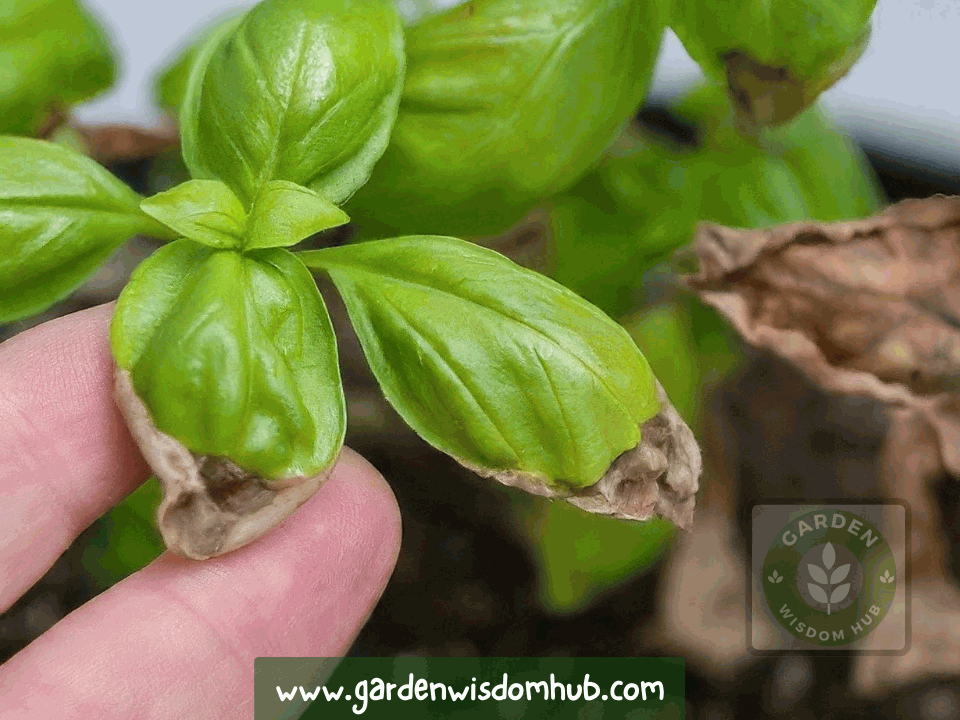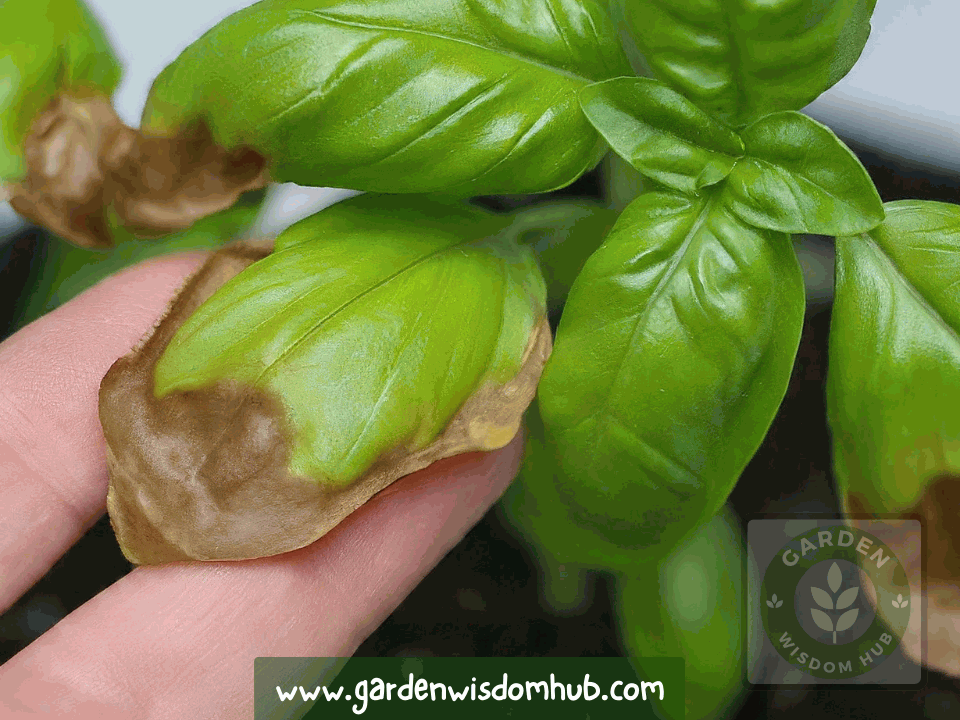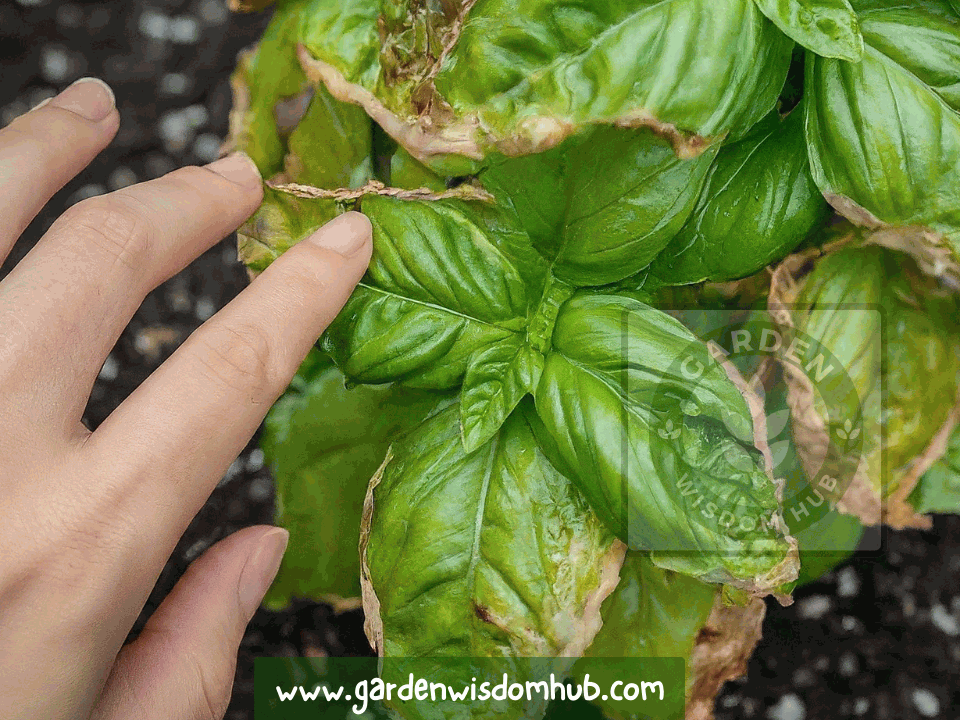Why are My Basil Leaves Turning Brown?
If your basil plant has brown spots or leaves, find out what’s wrong and how to fix it. Let’s discuss why basil leaves become brown and how to cure them.
Thirsty leaves:
Basil is thirsty and always needs water. Keep it hydrated with an inch of water weekly. Basil in a pot or the garden needs water when the soil is dry. Without enough water, a plant looks like it’s been in the desert for too long. It wilts and browns like it was overcooked in the oven. The scene is sad.
How to Fix: Watch soil moisture like a hawk; when the earth on top feels bone-dry, water that plant. To avoid root rot and waterlogging, make sure the soil drains well.
Pesty Animals
Basil plants, like other plants, get pests. Spider mites, trips, scales, bugs, and aphids cause problems. These pests can’t resist eating the sap, which turns the leaves dull as a wet day and burnt as a cookie. Bring in ladybugs and wasps to challenge those pests. Check those leaves and show unwelcome guests the door immediately.
Overwatering:
Overwatering basil plants turn their leaves brown. Too much water can cause root rot and fungal infections in plants.
Fix It: Water the basil plant only when the top inch of soil is dry. Not drown it! To prevent your plants from swimming in the container, make sure it has enough drainage holes.
Illnesses:
Basil has several issues! Fusarium, verticillium, downy mildew, and Cercospora leaf spot might affect it. I assure you, these illnesses can discolour basil leaves.
How to Fix It: Use fungicides to fight fungal infections. Don’t drown plants! They enjoy a drink, but too much water will drown them. They require airflow to keep healthy and happy, so allow them some breathing room. Allow your plants to breathe to avoid infections from spreading like wildfire.
Moderate sunlight:
Let There Be Light, But Not Too Much! Basil is sun-loving and needs 6-7 hours of sunshine daily. Finding the right light balance is crucial for plants. If they don’t get enough, their leaves may discolor. Too much direct sunshine won’t make them happy either.
How to fix it: Place the basil plant near a sunny window like on a beach trip. You may sunbathe your potted basil in a warm spot without overheating it. Indoor plant growth may require to grow lights! Even indoor plants will thrive with these bad boys. No worries, you’re protected!
Yoyo-like temperature change:
Basil adores the sun and warm weather. When it gets cold, those leaves brown faster than a cheetah seeking prey! It feels like a cold surprise party they didn’t sign up for. Protect your plants from cold surprises to keep them fresh and green.
How to Fix: Potted plants should be brought inside when the temperature decreases. A warm place indoors will protect them from the cold. Stop Jack Frost from ruining your garden! Wrap outdoor plants with a blanket or bring them inside. Better safe than sorry.
Fertilizer:
Too much fertilizer, especially nitrogen, can turn basil leaves yellow or brown. How to Fix It: Fertilize your basil plants sparingly. Once or twice a month should work. Make sure your soil pH is ideal for plants.
Too many transplants:
Transplants can cause basil plants to develop poorly and turn brown like potato chips. You shouldn’t move your plants like a bird with its head chopped off. Your pot will change colours more often than a chameleon if it’s too small!
Posts:
It appears such little pots are cramping the poor style of plants. They feel suffocated. If they can’t expand their roots, plants turn brown and miserable. Like, “Hey, give me some space, man!” If you want your plants to thrive and be healthy, enhance their living conditions.
How to Fix: Use larger pots to give roots room to grow. Give those pots a water escape route.
Basil facts that will amaze your mind:
Greeks felt this was a downer, but Indians considered it a holy plant. Basil isn’t only a cooking herb—it’s also healing! Eugenol and other essential oils in this bad boy are anti-inflammatory and antimicrobial. Basil tea might relieve headaches and respiratory issues. There are indeed over 60 basil varieties. All of them have unique flavours and fragrances, like a beautiful planet waiting to be discovered.
There are several basil varieties that people love. Sweet, Thai, lemon, and purple basil are available. These are popular alternatives. Basil contains a wealth of nutrients ready to improve your body! This monster has vitamins A, C, and K, plus iron, calcium, and magnesium. Like a nutritional party in your mouth! These nutrients are like the secret sauce that keeps your body running smoothly and fit. Basil, the best insect repellent, keeps pests away! Basil in your garden displaces mosquitoes, flies, and other pests. No one will know what struck them.
This guy smells so amazing it could knock a mosquito off its feet and scare away bugs like no other. Basil is versatile and fits many global cuisines. Similar to the secret sauce that makes Italian pesto, Thai curries, and Vietnamese pho sing. This can be paired with tomatoes, garlic, and many herbs and spices to produce a flavour explosion. Basil’s aromatic oils are a breath of fresh air in aromatherapy, reducing stress and anxiety. They say sniffing basil oil calms and clears the mind.
What Does Overwatered Basil Look Like?

You drowned your basil plant, huh? Let me tell you—overwatered basil is ugly. Droopy and sad like a sponge. Yellow leaves wilt like deflated balloons.
Suppose you don’t want your basil to look like a monsoon, waterless next time! If you water too much, your basil may develop beautiful yellow or brown leaves. Even though the soil is humid, your basil may be wilting. Talk about extra! Overwatering can cause root rot and fungal infections. It’s like sending them to the plant doctor one way.
How to Stop Basil from Browning?
Give basil leaves a drink regularly to keep them green. Watch out for bugs and cunning diseases. Give it lots of sun and avoid temperature surprises. Like Goldilocks finding the proper porridge, give your plants the right amount. Too much fertilizer can be like a smorgasbord they can’t resist, but it may cause a belly ache. Parent your plants responsibly, and don’t overfeed! Choose the right pot size to avoid repotting issues.
How to Treat Brown Spots on Basil Leaves?
Do your basil leaves have dark spots? No worries—we’ll cover you! These annoying spots are easy to remove. Following these simple measures can restore your basil’s vivid green colour quickly. Let’s start now. Take action on those nasty brown spots! Remove impacted leaves to show those spots who’s boss. This will stop the illness from spreading. It’s like sending those spots packing! – Are fungal infections bothering you? It’s time to get serious and use fungicides! These bad boys will eliminate that fungus faster than you think. Prepare to defeat that fungus and dismiss those uninvited guests. I promise you will chuckle your way to fungus-free bliss with these fungicides – Handling pests? Use insecticidal soap to teach them who’s boss! – Adjusting watering and lighting to make the plant feel great.
Can You Use Basil Leaves That Have Turned Brown?

Have you ever wondered how brown, funkier basil leaves can be used? It’s like making a silk purse from a sow’s ear! You could save those sad, wilting leaves, but you could be barking up the wrong tree like lipstick a pig. The truth is, brown basil leaves have seen better days. It indicates they’re past their peak and have lost their fresh flavour. My friend, throw out those brown leaves and find yourself. No worries if your basil leaves are brown. Despite their harshness, they can still cook. Avoid sticky or broken leaves. Fresh, green leaves offer your cuisine an amazing taste and appearance.
Watch this Video For More Guide Related to: Why Basil Leaves Turn Brown
Conclusion:
Find out why your basil leaves are turning brown and how to cure them to keep them healthy. These ingenious tips and solutions will give you basil leaves that are so green and luscious that they’ll make your taste senses dance! Play in the dirt in the garden. What a basil buzzkill.
Watch this Video For More Guide Related To:
FAQS About Basil Leaves Turn Brown:
What are the main reasons for my basil leaves turning brown?
Your basil plant may be deteriorating for several reasons. It may be sick from overwatering or lack of sunshine. Plants can have bad hair days, so maybe it’s just that. With a little care, your basil will be green and leafy again.
- Dry leaves: It looks dry here. Someone forgot to water this plant. It’s desert-dry here! Get the watering can and drench this guy. We don’t want it to shrivel into a prune.
- Pesky creatures
- Over-watering your plants.
- Pesty diseases that crash garden parties.
- Wild sunlight
- Temperature rise:
- Fertilizer: using too much fertilizer. Talk about overfeeding plants. Someone believed they were feeding the plants a gourmet dinner but instead started a fertilizer frenzy.
- It looks like you are making the garden a jungle. Slow down and let nature take over.
What are the two main reasons basil leaves turn brown?
There are two main reasons basil leaves get brown and sad:
- Water everywhere: Don’t overwater your plants. It’s like a root rot and fungal infection party that turns leaves brown.
- Pests: Basil leaves annoy spider mites, aphids, and thrips. These pests can’t resist eating the plant’s sap, making the leaves dark.
To learn more about Kitchen Garden Check out Our Guides:
Guide to Cantaloupe: Facts, Growing, and Varieties
Complete Guide to Growing Cantaloupe at Home
Harvesting and Enjoying Cantaloupe
Life Cycle of a Strawberry Plant
Guide to Banana Plant Growth Stages
Guide To an Apple Tree Growth Stages
Guide to Turmeric Plant Growth Stages
Guide to Cherry Tomatoes Growth Stages
Guide to Raspberry Plant Growth Stages & Life Cycle
James Porter
Welcome to our haven of gardening and plant care, where outdoor and indoor planting enthusiasts come together! At Gardening Wisdom Hub, we aim to provide you with the most authentic information on anything related to gardening, plant care, seasonal planting etc.
The author of our website is James Porter, an experienced industry veteran. He has a deep interest in everything green. James’s enthusiasm for exploring plants’ features and learning new gardening methods began at a young age. Gradually, his passion increased with time, leading him to become a highly esteemed professional. His extensive knowledge makes him a priceless resource for inexperienced and seasoned gardeners.

